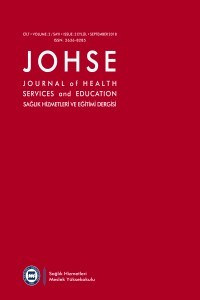Basınç Yaralarının Önlenmesinde Kanıt Temelli Uygulamalar
Basınç (dekübit) yaraları, cilt üzerinde uzun süreli basınçtankaynaklanan, bireyin yaşam kalitesini olumsuz etkileyen, cilt vealtındaki dokuda meydana gelen yaralanmalardır. Yaralar, en sıkvücuttaki kemik bölgelerini kaplayan cilt üzerinde gelişir. Basınçyaralarının gelişiminde risk faktörleri olarak; hareketsizlik, duyusalalgısal eksiklik, yetersiz beslenme, yetersiz hidrasyon, kan akışınıbozan tıbbi durumlar olarak belirtilmekte, erken tanılanmasınınönemi vurgulanmaktadır.Basınç yaralarına yönelik hemşirelerin, cilt bakımı, beslenme,pozisyon değişimi, eğitim ve kanıt temelli bir bakım sürdürmekonusunda duyarlı olmaları gerekir. Bu derleme, basınç yaralarınınnedenleri, ilişkin risk faktörleri ve basınç yaralarının önlenmesihakkında bilgiler içermektedir.
Evidence-Based Practices for the Prevention of Pressure Ulcers
Pressure (decubitus) ulcers are injuries to skin and underlyingtissue resulting from prolonged pressure on the skin and oneof the negative conditions that disrupt the quality of life of theperson. Ulcers most often develop on skin that covers bony areasof the body. Diagnosis and prevention of pressure ulcers as riskfactors immobility, lack of sensory perception, poor nutritionand hydration, medical conditions affecting blood flow is veryimportant.Nurses must to be sensitive about skin care, nutrition, positionchanging, training and maintain the care with evidence-basedabout pressure ulcers. This review contains information on causes,risk factors and prevention of pressure ulcers.
Keywords:
Prevention, Pressure, Ulcer,
___
- 1. Wurzer P, Winter R, Stemmer SO, Ivancic J, Lebo PB,Hundeshagen G, Cambiaso-Daniel J, Quehenberger F, Kamolz LP, Lumenta DB. Risk factors for recurrence of pressure ulcers after defect reconstruction. Wound Repair Regen. 2018; 26: 64-68. doi: 10.1111/wrr.12613.
- 2. National Pressure Ulcer Advisory Panel (NPUAP). NEW 2014 prevention and treatment of pressure ulcers: clinical practice guideline. Availbale from http://www.npuap.org/resources/educationaland-clinical-resources/prevention-andtreatment-of-pressure-ulcers-clinical-practice-guideline. Accessed at 12. 06.2018.
- 3. Orhan B. Practice for Preventing Pressure Ulcers: Evidence Based Practices. Archives Med Rev J. 2017; 26: 427-440 doi:10.17827/aktd.306004.
- 4. Gunes U. Steps of Evidence – Based Practice Process in Nursing. International Refereed J Nurs Res. 2017; 9: 171-187. doi: 10.17371/UHD2017.1.0006
- 5. Serraes B, van Leen M, Schols J, Van Hecke A, Verhaeghe S, Beeckman D. Prevention of pressure ulcers with a static air support surface: A systematic review. Int Wound J. 2018; 15:333-343. doi: 10.1111/iwj.12870.
- 6. Coleman S, Nelson EA, Keen J, Wilson L, McGinnis E, Dealey C, Stubbs N, Muir D, Farrin A, Dowding D, Schols JM, Cuddigan J, Berlowitz D, Jude E, Vowden P, Bader DL, Gefen A, Oomens CW, Schoonhoven L, Nixon J. Developing a pressure ulcer risk factor minimum data set and risk assessment framework. J Adv Nurs. 2014; 70: 2339-52.
- 7. Firat Kilic H, Sucudag G. The Scales Frequently Used in the Assessment of Pressure Sores. G.O.P. Taksim E.A.H.JAREN. 2017; 3: 49-54.
- 8. Beğer T. Pressure Sores in Intensive Care: Risk Factors and Prevention, 2004; http://www.yogunbakimdergisi.org/managete/fu_folder/2004-04/html/2004-4-4-244-253.html.
- 9. Saghaleini SH, Dehghan K, Shadvar K, Sanaie S, Mahmoodpoor A, Ostadi Z. Pressure Ulcer and Nutrition. Indian J Crit Care Med. 2018; 22: 283-289. doi: 10.4103/ ijccm.IJCCM_277_17.
- 10. Peterson MJ, Gravenstein N, Schwab WK, van Oostrom JH, Caruso LJ. Patient repositioning and pressure ulcer risk--monitoring interface pressures of at-risk patients. J Rehabil Res Dev. 2013; 50: 477-88.
- 11. Behrendt R, Ghaznavi AM, Mahan M, Craft S, Siddiqui A. Continuous bedside pressure mapping and rates of hospitalassociated pressure ulcers in a medical intensive care unit. Am J Crit Care. 2014; 23: 127-33. doi: 10.4037/ajcc2014192.
- 12. Porter-Armstrong AP, Moore ZE, Bradbury I, McDonough S. Education of healthcare professionals for preventing pressure ulcers. Cochrane Database Syst Rev. 2018; 5: CD011620. doi: 10.1002/14651858.CD011620.pub2.
- 13. Ham WH, Schoonhoven L, Schuurmans MJ, Veugelers R, Leenen LP. Pressure ulcer education improves interrater reliability, identification, and classification skills by emergency nurses and physicians. J Emerg Nurs. 2015; 41:43-51. doi: 10.1016/j.jen.2014.03.005.
- Başlangıç: 2017
- Yayıncı: Marmara Üniversitesi
Sayıdaki Diğer Makaleler
Kardiyovasküler Sistem Hastalıklarının Risk Faktörleri Üzerine Beslenme Durumunun Etkisi
Melike DEMİR DOĞAN, Fatma TAYHAN KARTAL
Basınç Yaralarının Önlenmesinde Kanıt Temelli Uygulamalar
İyonize Radyasyon ile Çalışan Tıbbi Görüntüleme Cihazlarının Yapısının Proje Temelli Öğrenimi
